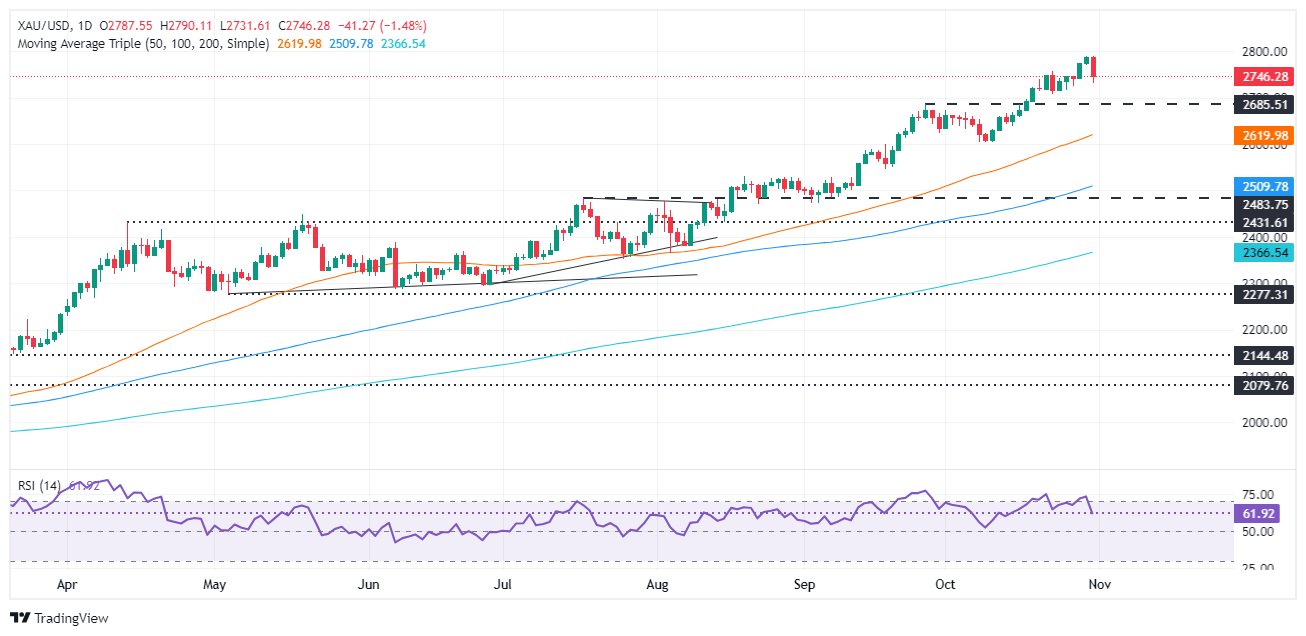Gold price retreats from record highs after mixed US data
- Gold dips from all-time high amid strong US jobs data and steady core inflation.
- Investors remain risk-averse ahead of November 5 US election, polls show a narrow race between Trump and Harris.
- Nonfarm Payrolls and Fed’s upcoming rate decision keep traders cautious.
Gold price retreated from all-time high on Thursday as traders failed to capitalize on falling US Treasury bond yields. Nevertheless, the precious metal is set to end the month with gains of over 4% and to remain above the $2,700 threshold.
The XAU/USD trades at $2745, down 1.49%. The US 10-year Treasury bond yield dropped almost two basis points to 4.284%.
Risk aversion is the name of the game ahead of the US Presidential Election on November 5. Meanwhile, the release of the Federal Reserve’s preferred inflation gauge, the Core Personal Consumption Expenditures (PCE) Price Index, alongside a strong jobs report, weighed on the precious metal price.
In the meantime, the latest opinion polls show that the race for the White House is narrowing between the Republican candidate, former US President Donald Trump, and the Democratic candidate, Vice President Kamala Harris.
US data from the Bureau of Economic Analysis (BEA) showed that headline inflation dipped. However, the core Personal Consumption Expenditures (PCE) Price Index, the Fed’s preferred inflation gauge, remained unchanged in October compared to September's level.
The US Department of Labor revealed that the number of Americans filing for unemployment benefits in the week ending October 26 dipped to its lowest level in five months.
Geopolitical tensions remain high in the Middle East, even though US Secretary of State Anthony Blinken stated “good progress” towards a ceasefire in Lebanon. Meanwhile, the Israeli military revealed the movement of ballistic missiles in Iran, hinting that a truce is far from being reached.
Bullion traders await the Nonfarm Payrolls report and have priced in a 95% chance of the Fed cutting interest rates by 25 basis points next week.
Daily Digest Market Movers: Gold price retreats amid goodish US data
- The US Dollar Index (DXY), which tracks the Dollar's value against a basket of six currencies, dropped 0.18% at 104.08.
- The US headline PCE decreased from 2.3% to 2.1% year-over-year (YoY), moving closer to the Fed’s 2% target. However, the Core PCE, which excludes volatile items, remained unchanged at 2.7% YoY, slightly above forecasts of 2.6%.
- US Initial Jobless Claims for the week ending October 26 fell from 228K to 216K, coming in below the forecast of 230K.
- Data from the Chicago Board of Trade, based on the December fed funds rate futures contract, indicates that investors estimate 49 basis points (bps) of Fed easing by the end of the year.
XAU/USD Technical Outlook: Gold price retreats below $2,750 as bulls take a breather
Gold retreated from record highs, yet it remains bullishly biased. If XAU/USD bulls keep the spot price above $2,700, look for further gains once it clears the psychological $2,750 figure, ahead of the all-time high at $2,790. A breach of the latter, and the $2,800 threshold is up for grabs.
On the other hand, if sellers move in and push prices below $2,708 where the October 23 daily low lies, it will expose the $2,700 mark. Up next is the September 26 swing high, which turned support at $2,685, followed by the 50-day Simple Moving Average (SMA) at $2,603.
Momentum suggests the non-yielding metal could consolidate as the Relative Strength Index (RSI) remains bullish. This means that buyers are gathering momentum.
Gold FAQs
Gold has played a key role in human’s history as it has been widely used as a store of value and medium of exchange. Currently, apart from its shine and usage for jewelry, the precious metal is widely seen as a safe-haven asset, meaning that it is considered a good investment during turbulent times. Gold is also widely seen as a hedge against inflation and against depreciating currencies as it doesn’t rely on any specific issuer or government.
Central banks are the biggest Gold holders. In their aim to support their currencies in turbulent times, central banks tend to diversify their reserves and buy Gold to improve the perceived strength of the economy and the currency. High Gold reserves can be a source of trust for a country’s solvency. Central banks added 1,136 tonnes of Gold worth around $70 billion to their reserves in 2022, according to data from the World Gold Council. This is the highest yearly purchase since records began. Central banks from emerging economies such as China, India and Turkey are quickly increasing their Gold reserves.
Gold has an inverse correlation with the US Dollar and US Treasuries, which are both major reserve and safe-haven assets. When the Dollar depreciates, Gold tends to rise, enabling investors and central banks to diversify their assets in turbulent times. Gold is also inversely correlated with risk assets. A rally in the stock market tends to weaken Gold price, while sell-offs in riskier markets tend to favor the precious metal.
The price can move due to a wide range of factors. Geopolitical instability or fears of a deep recession can quickly make Gold price escalate due to its safe-haven status. As a yield-less asset, Gold tends to rise with lower interest rates, while higher cost of money usually weighs down on the yellow metal. Still, most moves depend on how the US Dollar (USD) behaves as the asset is priced in dollars (XAU/USD). A strong Dollar tends to keep the price of Gold controlled, whereas a weaker Dollar is likely to push Gold prices up.

